Questions? 800-523-5874 | [email protected]
- Prepmaster™ Specimen Preparation Robot
- TEM Grids
- TEM Window Grids
- Omniprobe Nanomanipulation Systems
- K-kit Wet "Liquid" TEM Kit
- Specimen Mounts
- SEM Specimen Holders
- Index and Finder SEM Grids
- SEM for Forensics
- SEM Sample Preparation Station Materials
- Cryogenic Personal Protection Equipment
- Cryo Dewars & Flasks
- Cryogenic Grids & Accessories
- Cryogenic Vials & Racks
- Cooling Chambers & Ice Baths
- Prepmaster™ Specimen Preparation Robot
- Laboratory Microwave Ovens
- LYNX II Automated Tissue Processor
- EMS Poly III
- Microtomes
- Tissue Slicers
- Rapid Immersion Freezer
- Heaters & Chillers
- SEM Cooling Stage
- Glow Discharge Systems
- Sputter Coaters & Carbon Coaters
- Stages
- Freeze Dryers
- Critical Point Dryers
- Cryo-SEM Preparation System
- Specimen Transfer Systems
- Decontaminators
- Desiccators
- Centrifuges
- Dry Baths
- Stirrers, Hot Plates
- Vortexers & Magnetic Mixers
- Rotators & Rockers
- Ovens & Incubators
- Vibration Isolation
- Air Sampling
- Vacuum Pumps
 Citifluor Non-Hardening Antifadents
Citifluor Non-Hardening Antifadents
EMS Catalog #17970, 17971, 17973
| Glycerol Based | High Refractive Index | Glycerol Free | High Refractive Index |
| AF1 | CFM-1 | CFPVOH + AF100 | AF87 |
| AF1 + DAPI | CFM1 + AF | AF3 | |
| AF2 | CFM-2 | AFR3 | |
| CFMR2 | |||
| AF4 | CFM-3 |
Glycerol Based Antifade Reagents
| pH | RI | P/G* | |
| AF1 | ~9 | 1.463 | P |
| AF2 | NA | 1.473 | P |
| AF4 | NA | 1.476 | G |
* P = HDPE plastic bottle, G = Brown glass bottle
** Please ask for a quotation for larger volumes
Glycerol-based Mountant
AF1 Mountant Solution
Applications, properties and method of use.
This well-established product, has an anti-bleaching (anti-fadent) contained in glycerol-PBS (phosphate-buffered saline) solution and was specifically designed to alleviate the PHOTOBLEACHING of antibodies labeled with FITC (1-4).
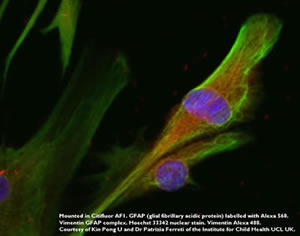
AF1 Example A
AF1 is useful for many other fluorochromes such as DAPI (1, 4, 5-10), rhodamines (11-17), Hoechst (11, 18-24), Alexa (9, 12, 25-29) and cyanine (Cy-3 and Cy-5) (30-37) dyes, Texas Red (4, 38-42)), phycoerythrins (43-48) and Green Fluorescent Protein (GFP) (7, 26, 39, 41, 49-54).
It is ideal for examining tissue sections and dead cells. In addition, it has been found useful for stabilizing the AUTOFLUORESCENCE (46, 55-57) of species such as cyanobacteria.
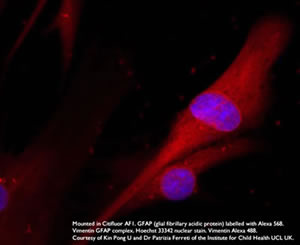
AF1 Example B
Storage and Shelf-Life
AF1 solutions may be stored at room temperature and ideally between 5° and 15°C and out of strong sunlight. The cap of the bottle or if using the pipette supplied with the material, the cap which covers the pipette delivery point, should always be replaced after use as a matter of good practice. Samples stored under these conditions for 6 months have shown no apparent deterioration. If the AF1 solution is being used in an assay, a control experiment should always be carried out.
Useful tips
In some cases, the reduction in the rate of PHOTOBLEACHING may be accompanied by a reduction in the initial intensity of the fluorescence signal. By diluting the AF1 solution with glycerol the reduction in the intensity of the fluorescence signal can oftentimes be mitigated.
Dilution of AF1 with glycerol will increase its refractive index whereas dilution with water will reduce its refractive index.
AF1 solutions have been employed where the techniques of fluorescence hybridization (FISH) (5-7, 9, 11, 17, 23, 28, 34-37, 58-60, 62-66) including CARD-FISH (63-65) and confocal laser scanning microscopy (CLSM) (1, 2, 29, 30, 36, 39, 50, 52, 54, 67, 68, 69) are being used.
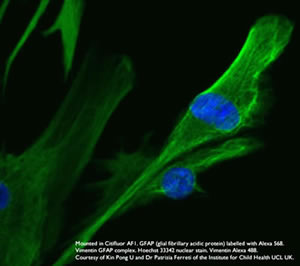
AF1 Example C
The solution has a pH of ~10, a refractive index of 1.463 at 20°C and is optically transparent from 300 nm into the 750 nm.
The solution should be pipetted (15 to 25 µl) onto the specimen and then a cover slip applied. Specimens mounted in this way may be kept in a refrigerator without having to seal the edges of the coverslip with a material such as nail varnish, and usually they retain their fluorescence for many months.
Obtaining the correct viscosity for your application
If the viscosity of the AF1 solution is too high for your purposes, it may be admixed with AF3 mountant (a PBS solution of the same antifadent as is present in AF1) solution. As the amount of AF3 solution is increased so the viscosity decreases.
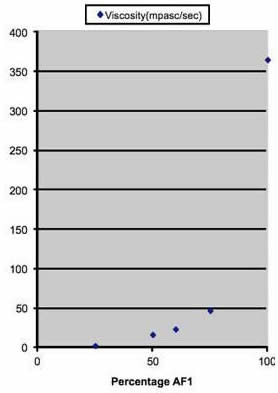 Conversely, if you wish to have a higher viscosity add AF2 mountant solution to the AF1 solution.
Conversely, if you wish to have a higher viscosity add AF2 mountant solution to the AF1 solution.
AF1 can be used to make up a hardening mountant. To a poly (vinyl alcohol), e.g. Airvol 203 (Air products) or Mowiol® 4-88 (Calbiochem) solution (20% in water), add ~20% by volume of AF1. This solution is best used soon after it is prepared as it doesn't have a long shelf-life
AF1 plus DAPI Mountant Solution
This is a new addition to the range of Citifluor products and is composed of an AF1 mountant solution to which DAPI has been added at a concentration of 2 µg per ml. If a lower concentration of DAPI is required, dilution should be carried out by adding a further quantity of AF1 solution. The solution will be of value to those using the FISH technique.
It is recommended that the solution be kept in a tightly sealed brown glass bottle and stored in a refrigerator at a temperature between 0° and 5°C.
AF2 Mountant Solution
Properties and method of use
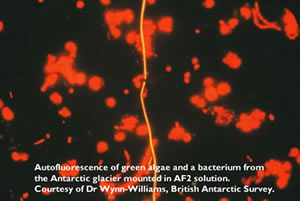
AF2 Example A
AF2 is a mountant solution composed of glycerol and an antifadent and is optically transparent from 300 nm into the 750 nm. It was specifically designed to stop the photobleaching of the fluorescein moiety of FITC (70-73) labeled biological specimens.
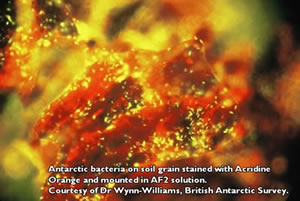
AF2 Example B
Its application is not however limited to FITC labeled materials and has been used with advantage with many other fluorochromes including rhodamines (71), DAPI (71, 73, 74-78) and GFP (74, 80-82). It is ideal for examining tissue sections and dead cells. An aqueous solution (75% AF2 to 25% water v/v) has a pH of ~10.
AF2 solutions have been employed where the techniques of fluorescence in situ hybridization (FISH)(73, 76, 77, 79, 83), and confocal laser scanning microscopy (CLSM) (70, 71, 73, 75, 79) are being used.
Storage and shelf-life
The solutions are of medium viscosity and are water-white in appearance. They may be stored at room temperature and ideally between 5° and 15°C and out of strong sunlight. The cap of the bottle or if using the pipette supplied with the material, the cap which covers the pipette delivery point, should always be replaced after use as a matter of good practice and also to prevent the ingress of water (due to the glycerol being hygroscopic). Samples stored under these conditions for 6 months have shown no apparent deterioration. If the AF2 solution is being used in an assay, a control experiment should always be carried out.
Useful tip
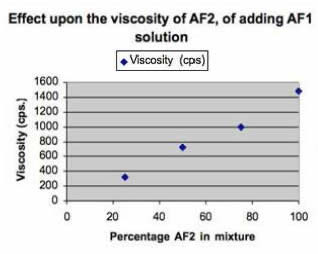 If the viscosity of the AF2 solution is too high for your purpose, it may be reduced by the addition of either AF1 or AF3 solutions.
If the viscosity of the AF2 solution is too high for your purpose, it may be reduced by the addition of either AF1 or AF3 solutions.
The AF2 mountant solution should be pipetted (15 to 25 µl) onto the specimen and then a cover slip applied. If the slides are stored in a refrigerator, the viscosity of the mountant solution increases thereby helping too keep the cover slip in place. There is no need to seal the cover slip with nail varnish. Specimens mounted in AF2 solutions have been kept in this way for many months without loss of fluorescence intensity.
F2 has also been used to create a hardening formulation (84) by adding it to an aqueous solution of poly (vinyl alcohol), e.g. Airvol 203 or Mowiol® 4-88.
AF4 Mountant Solution
Properties and method of use
AF4 is a solution composed of the antifade reagent n-propyl gallate (85) dissolved in glycerol and is optically transparent between 400 nm and 750 nm. If the solution is to be used as a mountant solution as supplied, wash the specimen with a buffer of appropriate pH for the fluorochrome label (so as to maximise the fluorescence intensity) and then apply a few drops of AF4.
Alternatively, buffer solutions may be added to AF4 to create your own mountant solution but it is inadvisable to make solutions containing buffer in excess of 30% by volume since this leads to a dramatic reduction in shelf-life. N-Propyl gallate is recommended in particular when DAPI is being as the fluorochrome.
Storage and shelf-life
The mountant solution should be stored in brown glass bottles at temperatures between 5° and 15°C and shielded from strong sunlight. The cap of the bottle should always be replaced after use as a matter of good practice and to prevent the absorption of moisture from the atmosphere. Samples stored under these conditions for 12 months, have shown no apparent deterioration and in particular no discoloration. If the AF4 solution is being used in an assay, a control experiment should always be carried out.
Its application is not however limited to DAPI labeled materials and has been used with advantage with many other fluorochromes including fluorosceins, Alexa and Hoechst dyes and rhodamines. It is ideal for examining tissue sections and dead cells. The solution should be pipetted (15 to 25 µl) onto the specimen and then a cover slip applied. If the slides are stored in a refrigerator, the viscosity of the mountant solution increases thereby helping too keep the cover slip in place. There is no need to seal the cover slip with nail varnish.
Glycerol Based High Refractive Index Solutions
Reagents for Transmission Microscopy as well as Fluorescence Microscopy
All the following solutions have a refractive index of ~1.52 at room temperature (20°C) and are freely miscible with water. They may be used as an immersion oil in the standard way as well as a mountant solution. The refractive index of the materials makes them ideal for use when specimens are being examined by confocal laser scanning microscopy (CLSM)). They show very little absorption above 400 nm.
The CFM range of mountant solutions should only be used with samples that have been fixed (4% paraformaldehyde in phosphate buffered saline for 30 minutes). The crosslinking (fixing) of the sample prevents non-covalently bonded fluorochromes, e.g. DAPI, Hoechst dyes, from becoming detached from the specimen etc.
If some bleeding of the dye(s) is still observed a further fixation with paraformaldehyde should be carried out. For sealing the coverslips, when CFM mountant solutions are used, the product CoverGrip® marketed by Bioutium has been recommended. (We are grateful to Dr. Sean Speese, Jungers Center for Neuroscience, Oregon, U.S.A.for these many helpful suggestions).
The two images below are examples of Citifluor product applications, kindly provided by Dr. Sean Speese:
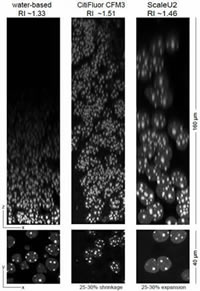
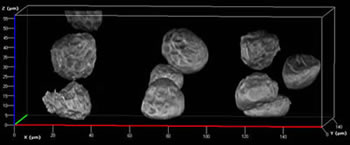
Above: 63x1.4 NA PlanApo / 1 Airy / Nyquist sampling xyz / Zeiss LSM 710 Genetically expressed GFP-tagged nuclear protein in brain slice.
Right: 3D rendering of nuclei stained for LamDm0 in Drosophila tissue, mounted in CFM3 + antifade, imaged via confocal microscopy. Notice the staining intensity is consistent throughout the entire 55 µm stack with no increase in spherical aberration.
CFM-1
This glycerol-phosphate buffered saline based solution has been specially formulated so as to have a refractive index of ~1.52 (at room temperature).
The solutions are of medium viscosity, are water-white in appearance and have a pH of ~7.5 and may be used for conventional microscopy (transmission microscopy) as well fluorescence microscopy.
Storage and shelf-life
The solution may be stored at room temperature. The cap of the bottle should always be replaced after use. Samples stored under these conditions for 6 months have been found to exhibit little apparent deterioration.
A few drops of the solution should be applied to the specimen, followed by a cover slip. An immersion oil (which may be a CFM solution if its viscosity is appropriate) is applied on top of the coverslip in the usual way.
CFM-1 Plus Antifadent
This glycerol-phosphate buffered saline based mountant solution has been specially formulated so as to have a refractive index of ~1.52 (at room temperature) and contains an antifadent to retard the bleaching of fluorochromes.
The solution is of medium viscosity, are water-white in appearance and has a pH of ~9.
Storage and shelf-life
The solution may be stored at room temperature. The cap of the bottle should always be replaced after use. Samples stored under these conditions for 6 months have been found to exhibit little apparent deterioration.
A few drops of the solution should be applied to the specimen followed by a cover slip. An immersion oil (which may be a CFM solution if its viscosity is appropriate) is applied on top of the coverslip in the usual way.
CFM-2
A few drops of the solution should be applied to the specimen followed by a cover slip. An immersion oil (which may be a CFM solution if its viscosity is appropriate) is applied on top of the coverslip in the usual way.
Storage and shelf-life
This glycerol-tris-amine buffered mountant solution, has been specially formulated so as to have a refractive index of ~1.52 (at room temperature). It has a pH of ~8.5 which is appropriate for fluorescein conjugates.
The solution may be stored at room temperature. The cap of the bottle should always be replaced after use. Samples stored under these conditions for 6 months have been found to exhibit little apparent deterioration.
CFMR2 – A high refractive index mountant especially designed for samples labeled with GFP
The Citifluor CFM series have proved very useful for imaging materials using CLSM. Samples labeled with GFP pose a special problem since the retention of a good image during imaging and upon storage is dependent upon the mountant solution containing oxygen. The classical antifadents consume oxygen when the fluorochromes are irradiated and in the case of GFP this accelerates the loss of the image.
CFMR2 contains a unique antifadent that does not de-oxygenate solution but nevertheless, affords protection to the GFP.
As with the other Citifluor CFM solutions the mountant has a similar refractive index to the biological tissue and hence enables a good depth of viewing within the sample.
CFM-3
This antifadent is useful for retarding the photobleaching of DAPI, Alexa, Hoechst and cyanine dyes.
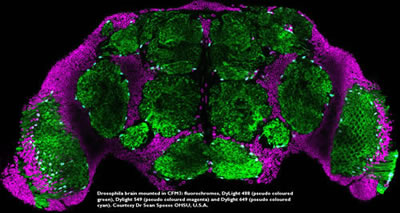
CFM-3 Example
A few drops of the solution should be applied to the specimen, followed by a cover slip. An immersion oil (which may be a CFM solution if its viscosity is appropriate) is applied on top of the coverslip in the usual way.
Storage and shelf-life
This glycerol-phosphate buffered saline based mountant solution has been specially formulated so as to have a refractive index of ~1.52 (at room temperature) and contains a phenolic type antifadent to retard the bleaching of fluorochromes. The solution is of medium viscosity, is water-white in appearance and has a pH of ~6.5.
The solution may be stored at room temperature. The cap of the bottle should always be replaced after use. Samples stored under these conditions for 6 months have been found to exhibit little apparent deterioration.
Glycerol-Free Non Hardening Mountant Solutions
AF3
This well-established product was specifically designed to alleviate the PHOTOBLEACHING of specimens labeled with FITC (86,87). AF3 is useful for reducing the photobleaching of many other fluorochromes such as DAPI (88-93), rhodamines (94) and Alexa dyes (88, 91,95). It has been found useful for examining live cells although it should be noted that the antifadent may lead to cell lysis.
Storage and shelf-life
AF3 has an anti-bleaching (antifadent) contained in PBS (phosphate-buffered saline) solution. The solution has a pH of ~10, a refractive index of 1.338 at 20°C and is optically transparent from 300 nm into the 750 nm.
AF3 solutions have been employed where the techniques of fluorescence in situ hybridization (FISH) (86, 88, 89, 90, 97) and confocal laser scanning microscopy (CLSM) (88, 89, 90, 91, 93) are being used.
The low refractive index of AF3 makes it ideal for use with the recently introduced technique of Total Internal Reflectance Spectroscopy (TIRF), where a large difference in refractive index between glass and the mounting medium is required (98, 99).
The solution should be pipetted (15 to 25 µl) onto the specimen and then a cover slip applied.
AFR3 A new antifadent solution for use with live cells
The imaging of live cells in conjunction with an antifadent poses problems. The classical antifadents, amines and phenols can interact with the cell surface leading to lysis. The new solution contains an antifadent at a much lower concentration than that used is in the currently available solutions and is designed to show minimal phototoxicity. Unlike other antifadents it does not de-oxygenate the solution. The antifadent is supplied in a phosphate buffered saline solution. Texas Red, Alexa and Cyanine dyes have been stabilised with the new antifadent. This solution has a refractive index of 1.34 and hence is ideally suited for use with Total Internal Reflectance Microscopy (TIRFM).
CFPVOH plus AF100
Although this combination of reagents is designed for use as a hardening mountant system (solid mountant system), it may be used in liquid form provided the water is not allowed to evaporate.
A few drops of the solution should be applied to the specimen followed by a cover slip. Evaporation of the water under these circumstances takes a few hours.
Storage and shelf-life
The CFPVOH is an aqueous solution of poly (vinyl alcohol) and the AF100 is a phosphate-buffered saline solution of an antifadent.
Solutions should be made up by mixing 1 part by volume of AF100 with 9 parts by volume of CFPVOH. These solutions should be used within 10 hours as the efficacy of the antifadent reduces with time. With this in mind, it is better to make up the mixture prior to use and not to rely on keeping solutions.
Glycerol Free High Refractive Index Mountant Solution
AF87
This product is an immersion oil of low fluorescence that contains an antifadent. It is immiscible with water, is of medium viscosity and has a refractive index of ~1.52 at room temperature (20°C ). This high refractive index makes it ideal for when specimens are being examined by confocal laser scanning microscopy (CLSM) (100).
For use as a mountant, it is necessary to dry (dehydrate) the specimen before applying the AF87. Dehydration may be carried out by washing the specimen with ethanol, followed by drying in air (101, 102).
AF87 has been found useful for examining specimens generated using the technique of FISH, labeled with the fluorochromes DAPI (103-105) and Cy dyes (101, 103).
Bottles of AF87 should be stored at room temperature with temperatures of 50°C or lower being avoided since the low temperature may cause the development of a sediment in the bottle and a reduced antifadent performance.
